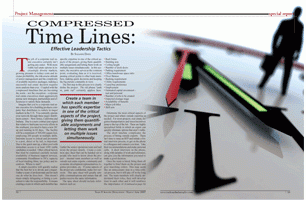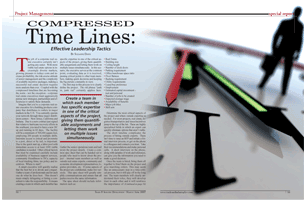

The job of a corporate real estate executive certainly isn’t getting any easier. With more viable real estate options in increasingly diverse markets, growing pressure to reduce costs and increase profitability, the risk-averse attitude of senior management and the complexity of available incentive packages, making a successful real estate decision requires more analysis than ever. Coupled with the compressed time lines that are becoming the norm - not the exception - corporate real estate executives must aggressively pursue new strategies, partnerships and efficiencies to satisfy these demands.
Imagine that you’re a corporate real estate executive for a building products company that distributes to outlets in major markets in the U.S. You currently operate your network through 3 major distribution centers – New Jersey, California and Indiana. Due to a new contract just signed that relates to hurricane recovery efforts in the southeast, you need to have a new DC up and running in 60 days. The facility will be a minimum of 500,000 sq. ft, employing 200 people in multiple shifts. Interstate access is critical and proximity to a port, direct or by rail, is important. Due to the quick start up, a labor pool with immediate access to at least 1000 viable candidates is needed. Other critical factors that must be examined carefully include availability of business support services, community friendliness to DCs, capacity of local trucking firms, tax policy and incentives. Where to start?
A smart executive will quickly realize that the best bet is to divide and conquer. Gather a team of professionals and let each one do what he does best. This doesn’t mean simply delegating or hiring a consultant to take the responsibility. It means creating a team in which each member has specific expertise in one of the critical aspects of the project, giving them quantifiable assignments and letting them work on multiple issues simultaneously. In this scenario, the executive serves as the common point, evaluating data as it is received, passing critical points to other team members, making quick decisions and keeping the big picture constantly in view.
The first step in this process is to clearly define the project. The old phrase “junk in, junk out” certainly applies here. Gather the senior operations team and nail down the project details. Create a common spec sheet that can be handed out to people who need to know about the project – internal team members as well as outside real estate experts, community and economic development representatives, logistics providers, etc. If some aspects of the project are confidential, make two versions. This spec sheet will greatly simply communications and ensure that all parties receive the same information.
The spec sheet should include information such as:
Real Estate
Building Size
Ceiling height
Number of Dock Doors
Parking requirement
Office/warehouse space ratio
Floor flatness
Racking requirement
Utility requirements
Lease/buy preference
EMPLOYMENT
Estimated capital investment - real and personal
Number of jobs to be created
Expected average wage
Availability of benefits
Major job titles
Skill sets
Determine the most critical aspects of the project and where outside expertise is needed. For most projects, real estate, logistics/transportation and taxes/incentives jump to the top of the list. These are highly specialized fields in which an expert can quickly eliminate options that aren’t viable.
The short time line complicates the process of hiring outside experts. There isn’t time to issue an RFP and initiate a formal interview process, so get on the phone to colleagues and contacts you trust. Take their recommendations and make personal calls. A short interview on the phone, along with samples of work and references, can give you the information you need to make a good decision.
Once the team is hired, bring them all together to brief them on the project and give marching orders. This may seem like an unnecessary step in a time-critical process, but it will pay off in the long run. The team members will clearly understand their roles, they will develop trust in each other and it will reinforce the importance of communication and timing.
Here’s how this process might play out for the project above. The real estate executive hired 2 experts – a real estate professional and a site selection/incentives consultant.
At the first meeting, determine the viable search area. Based on supplier and customer considerations, as well as high level data on transportation options, make a list of potential states. Once this decision is made, turn the real estate expert loose to find options. Given the timing, finding an existing building is critical. The availability of a 500,000 sq. ft. facility, ready to go in 60 days, will be the driver of this project. Many communities, even states, will be eliminated immediately.
While the real estate consultant is working his magic, the site selection/incentives team can begin broad research for the target states. Tax structure, worker’s compensation, basic incentive information, labor rates and availability, and responsiveness of state and local government should be examined.
Within a week, the real estate consultant locates seven viable buildings in three states. You review the information and decide that two buildings are not suitable. Based on the information provided by the site selection/incentives team, one state is eliminated due to an unfavorable inventory tax issue. Four viable buildings remain and the action kicks up a notch.
The real estate consultant begins due diligence on each viable building. This includes, at a minimum, environmental review, building structure analysis for needed renovations, zoning, fire protection, local zoning, etc.
At the same time, the site selection/incentives consultant creates a comparative matrix of key factors including site specific tax rates and liability, labor availability and wage rates, likely incentives, utility costs, community attitude and friendliness to business. Drawing on a network of economic development contacts, the consultant can quickly locate key community contacts for each site. He can promote the project in a manner to generate the most interest by local communities. The matrix of comparative information is completed for each site. The consultant should provide the information to you and also interpret the information and rank the potential sites in terms cost and suitability for the project.
Site visits to all the potential communities should be done by the entire team. The corporate real estate executive will be able to get a first hand look at each community and meet the key players in each community. The real estate consultant will coordinate the building visits, while the site selection/incentives consultant coordinates employer interviews, community tours, meetings with state and local government representatives, utility company representatives, local training providers. The corporate real estate executive should expect to just “show up” on these visits, with all the details handled by the consulting team. After this visit, the list of potential facilities can be quickly narrowed to finalists.
In order to maximize negotiating potential, it is important to keep an element of competition at this point. However, it is never a good idea to pursue options that truly are not viable for the project or overestimate job or investment figures to get maximize incentive commitments. Virtually all programs are performance based or have clawback penalties if goals are not met. A true projection of the impact of the project on the community is the best bet for securing an incentive package that is fair for both the company and the community.
At the same time, it is very important to keep both sides of the project working together. If real estate is chosen before incentives are negotiated, it may lessen the potential incentive package. If a great incentive package is negotiated, but the site is not viable, it will cost the team valuable time to pursue additional negotiations in a different community.
While the outside experts are working their portions of the project, the corporate real estate executive can focus on the big picture. He can work closely with the operations team as they put together the new operation. He can communicate with senior management to ensure that there are no surprises at the end of the project. As information changes as a result of these discussions, the executive can quickly evaluate and communicate changes to the real estate and site selection team. Adjustments can be made as necessary.
As the field narrows, the real estate consultant can negotiate firm lease rates and terms for the project. At the same time, the site selection/incentives consultant can secure community commitments for incentives and other assistance. These numbers will be factored into the final cost model.
When it is time for a final recommendation to be made, data from both the real estate team and the site selection/incentive team should be combined with data from the operations team so the best location decision can be made. A concise, yet thorough, summary of costs and benefits for each finalist site should be presented to the corporate real estate executive. The entire team should sit down together to discuss and evaluate this data. It is likely that a clear winner will not be apparent. It will take the expert opinions of all team members to recommend the most viable site. This meeting should be held in time to allow for questions and clarifications to the finalist communities before presentation of the final recommendation to the senior management team.
Today’s compressed time lines do make the pressure-filled job of the corporate real estate executive even more difficult. However, by working with the right team of professionals, the job can be made easier. By setting clear goals and objectives early in the process, communicating openly and hiring experts for critical analysis of complex issues, the real estate executive can make a confident decision regarding the new location.
